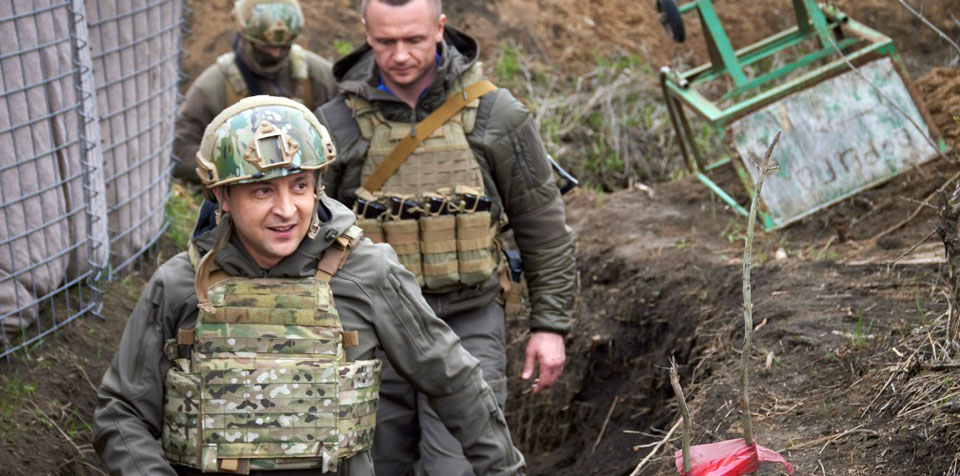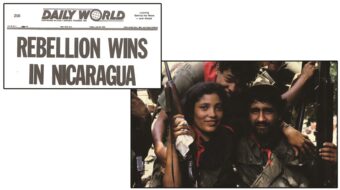
Major media, led by the New York Times and MSNBC, are stepping up a campaign that could result in military action by NATO and the U.S. against Russia. They apparently want to add an anti-Russia campaign to their ongoing attacks on China. If these corporate press outlets are to be believed, Russia’s “massing of troops” inside its own territory near the Ukrainian border is proof of danger. They say nothing about the fact that U.S. troops, under the guise of NATO, are actually inside Ukraine training the right-wing military there for a fight with Russia.
The Times on Monday said that Ukrainians “ousted” a Russia-friendly president in 2014 and that they are “increasingly in favor” of “binding their country” to Western institutions.

What really happened, of course, is that the U.S. unearthed the memory of well-known World War II-era fascist leader Stepan Bandera and promoted his movement to stage a coup against the “pro-Russian” president, Viktor Yanukovych, who had been elected by the Ukrainian people themselves. His crime was that he refused to back down to EU and IMF demands that austerity be imposed on Ukraine. Instead, he appealed to Russia for economic help.
This led to the fascist coup and a new government that banned opposition political parties, including the widely-supported Communist Party. It even banned the use of the Russian language, the primary language of 40% or more of the Ukrainian people. It also put well-known fascists in charge of the country’s police and military as a reward for fascist support of the coup.
A requirement of the anti-Russia campaign inside Ukraine is that the Russian language be suppressed and extreme Ukrainian nationalism be promoted. Current President Volodymyr Zelensky speaks Ukrainian in public these days, even though he rose to fame over his many years as a Russian comedian in Ukraine.
Hundreds of trade union leaders and activists were murdered by the new right-wing Ukrainian government shortly after it came to power. Among its many crimes, the fascist government now praised by the U.S. as a beacon of democracy also opened up the country to the sale and use of food grown in contaminated regions near the Chernobyl nuclear reactor that had infamously melted down back in 1986. The “pro-Russian” government ousted by the fascists had forbidden the sale and use of food grown in nuclear-contaminated regions.
Unmentioned entirely in the New York Times article Monday is the fact that when the Soviet Union was dismantled, NATO agreed to not expand one inch toward the east. It almost immediately violated that treaty and moved troops, including U.S. forces, into countries like Poland, the Czech Republic, Hungary, and others—all of which had been part of the Soviet-led Warsaw Pact alliance.

To add insult to that injury, NATO also moved troops into countries that were part of the Soviet Union itself, including Latvia and Lithuania among others. Former Soviet republics, like Belarus, that refuse NATO control or incursions, end up heavily sanctioned. NATO and the U.S. have also blatantly been training troops inside Ukraine.
Nuclear missiles have been placed in Germany, only ten minutes away from Moscow if launched—another violation of agreements made at the end of the Cold War. If nuclear missiles were moved into Ukraine, it would give people in Moscow less than five minutes to react. Imagine what the U.S. would do if there were Russian military bases in Canada, Mexico, the Caribbean, and other places. The United States maintains over 700 bases around the world, many of which surround Russia from all sides. Russia, by contrast, has only a single military installation outside its borders, in Syria.
At least part of the reason for possible Western aggression against Russia is the desire of the fossil fuel monopolies to control the world energy market. The U.S., via sanctions, already forced suspension of an extension of a Russian pipeline intended to deliver natural gas to Germany and Europe. The motivation for the pipeline sabotage was not to save the environment but rather to force Europe to instead purchase the fracked gas that U.S. fossil fuel moguls are pushing.
One of the outrageous “concerns” voiced by the U.S. in the current Russophobia campaign is Russian control of the Russian region of Crimea which, since 1954, was administered by the Ukrainian Soviet Socialist Republic and later by Ukraine with the agreement of Moscow. When the Soviet Union was dismantled, everyone, including the U.S., supported keeping control of a nuclear-capable naval base in Crimea under Russian control because no one wanted to risk such a base falling into irresponsible hands, which would have happened had the newly-installed fascist government in Kiev taken control.
Seeing the persecution the fascist Ukrainian government was visiting on ethnic Russians everywhere in Ukraine, the Russian-majority population of Crimea voted to switch back to the administration of their region to Russia in 2014, thus also lessening the danger that would have been posed by fascist control of the naval base there.
In order to achieve economic control of Russia, Western capitalist interests are pushing their full-fledged drive to turn Ukraine into a base against Russia. Russians note that laws against the use of the Russian language and the invitation by the Ukrainian government to Western countries to come in and do joint military maneuvers with them are examples of how this is being done.
“It would be no exaggeration to say that the course of forced assimilation of an ethnically pure Ukrainian state against Russia is comparable in its consequences to use of a weapon of mass destruction against us.” Russian President Vladimir Putin wrote recently, in a reflection of the feelings of vast majorities in Russia, including those of his political opponents.
For centuries, there has been a close relationship between Ukraine and Russia. In fact, Kiev, now the capital of Ukraine, is the historic location of the founding of Russia itself in the Middle Ages. Popular Russian writers come from Ukraine. Long-time Soviet leader Leonid Brezhnev, who was in office from 1964 to 1982, was also Ukrainian.

There are millions of Ukrainians and Russians who are part of the same families. Opinion polls published by the right-wing Ukrainian government show an even split between those favoring membership in NATO and those opposed. The last polls taken by independent outfits in 2012, however, showed only 10-12% favoring NATO membership. This explains the fervor with which the right-wing government in Kiev has been pushing its anti-Russia efforts.
The world cannot afford to allow NATO and the U.S. to push their dangerous campaign against Russia. The world has too many needs that can only be solved by international cooperation. U.S. and NATO hostility toward Russia benefits no one except the military and corporate energy interests behind so much of the trouble in the world.
Let’s hope that President Biden keeps this in mind as he prepares for his coming meeting with President Putin. The war hawks willing to risk conflict with Russia are the same people who oppose his economic agenda here at home.












Comments